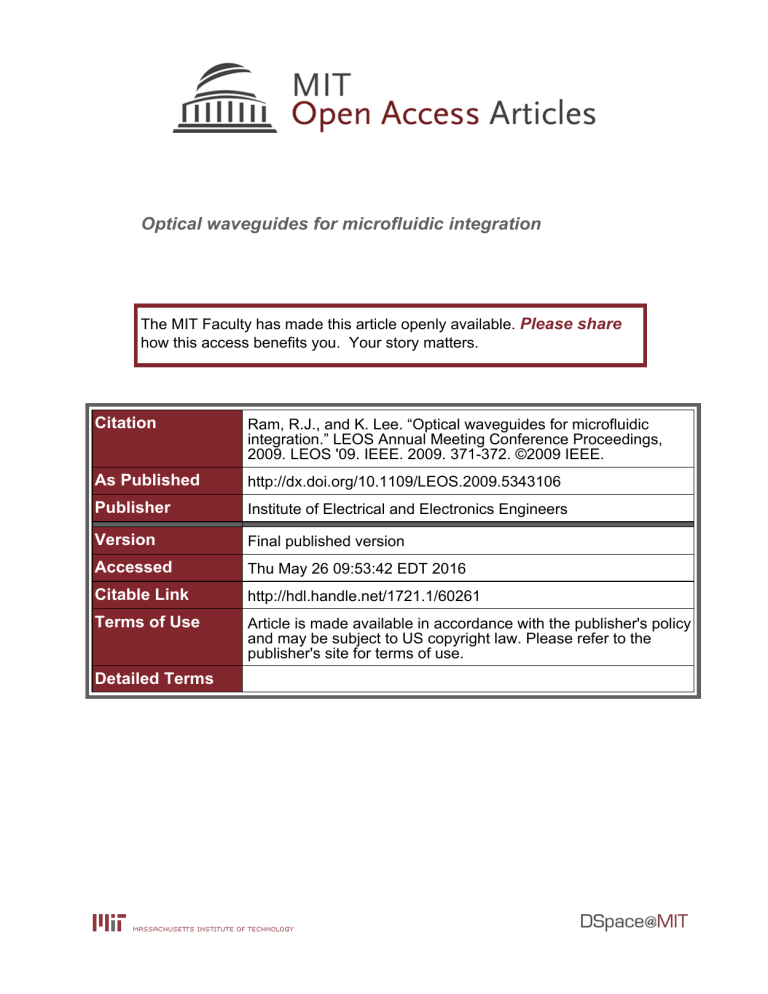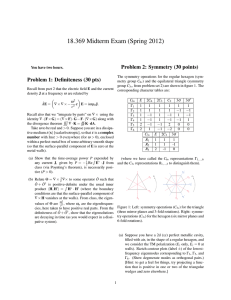Optical waveguides for microfluidic integration Please share

Optical waveguides for microfluidic integration
The MIT Faculty has made this article openly available.
Please share
how this access benefits you. Your story matters.
Citation
As Published
Publisher
Version
Accessed
Citable Link
Terms of Use
Detailed Terms
Ram, R.J., and K. Lee. “Optical waveguides for microfluidic integration.” LEOS Annual Meeting Conference Proceedings,
2009. LEOS '09. IEEE. 2009. 371-372. ©2009 IEEE.
http://dx.doi.org/10.1109/LEOS.2009.5343106
Institute of Electrical and Electronics Engineers
Final published version
Thu May 26 09:53:42 EDT 2016 http://hdl.handle.net/1721.1/60261
Article is made available in accordance with the publisher's policy and may be subject to US copyright law. Please refer to the publisher's site for terms of use.
TuDD1 (Invited)
15.30 - 16.00
Optical Waveguides for Microfluidic Integration
Rajeev J. Ram and Kevin Lee
Research Lab of Electronics, Massachusetts Institute of Technology, Cambridge, MA 02139 rajeev@mit.edu
Abstract: A scalable polymer backplane for dense integration of photonics with lab-on-a-chip systems is presented. A high-throughput cell culture chip employing waveguides for monitoring and control of culture conditions is used to illustrate integration options.
The miniaturization of laboratory operations to microscale platforms has attracted a great deal of attention from researchers and entrepreneurs. Parallel integration of similar devices has supported the drive towards highthroughput analysis such as DNA hybridization and sequencing, protein affinity assays and combinatorial optimization of lab processes. The information from these lab-on-a-chip assays is typically conveyed optically for example by fluorescence intensity or color change. Today, optical interrogation of lab-on-a-chip systems employs traditional microscopes and high-performance cameras – eliminating possible advantages associated with cost and size for lab-on-a-chip systems. Photonics and optoelectronics are a path to move these chips out of the lab and into hospitals, clinics, factories, and homes.
Recently, we have developed a single layer waveguide approach for low cost, high speed fluorescence detection necessary in devices such as microflow cytometers and fluorescence lifetime chemical sensors. A polymer optical backplane capable of generic fluorescence detection within microfluidic chips is demonstrated using large core polymer waveguides and vertical bends (Figure 1) [1]. The waveguides are fabricated through a new process combining mechanical machining and vapor polishing with elastomer microtransfer molding. A backplane approach enables general optical integration with planar array microfluidics since optical backplanes can be independently designed but still integrated with planar fluidic circuits. Fabricated waveguides exhibit a loss of 0.1 dB/cm at 626 nm and a measured numerical aperture of 0.5. In addition to vertical bends for out-of-plane collection and excitation, polymer waveguides are doped with organic dyes to provide wavelength selective filtering within waveguides, further improving optical device integration. With large core low loss waveguides, fluorescence collection is improved and measurements can be performed with simple LEDs and PIN detectors. The backplane is coupled to both a microfluidic channel to demonstrate intensity based fluorescence detection and an oxygen controllable microbial cell culture chip [2] utilizing lifetime based fluorescence detection to measure oxygen concentration.
Waveguide fluorescence collection performance is equivalent to a back collection geometry fiber bundle system consisting of nine 500 µm core diameter collection fibers.
Fig. 1 A schematic is drawn showing the side view and top view of the integrated oxygen sensor chip. The waveguides are designed to illuminate and collect fluorescence from the oxygen sensor inside the fluidic chamber located 1 mm above the silvered bends [1].
Fig. 2 The fabricated device is shown consisting of 4 waveguide sensors butt coupled to photodetectors. The optical backplane rests underneath a miniature bioreactor array containing 4 integrated oxygen sensors. Darker sections of the waveguides result from mixing the core polymer with organic dye and acts as a filter for the 590 nm excitation source [1].
While this approach provided for compact fluorescence detection, the single layer design is limited in its ability to scale for a large density of sensors, a situation common for parallel array systems often found in microfluidics.
While a single layer backplane must grow in area to accommodate waveguide signal routing, a multilayer backplane can grow in layers, reducing the total size of the detection chip. In addition to decreasing size and complexity, a multilayer approach can route multiple waveguides in different layers to a single photodetector to provide
978-1-4244-3681-1/09/$25.00 ©2009 IEEE 371
multiplexing more efficiently than a single layer. By frequency multiplexing multiple sensors to a single detector, data acquisition speed is dramatically reduced, a necessary improvement for scaling to large arrays.
For multilayer structures, consistent collection efficiency over multiple layers can be achieved using vertical vias for collection. The final device shown in Figure 3 consists of 3 different waveguide/via layers and is capable of performing four different fluorescence measurements simultaneously with a single photodetector. The output waveguide area measures 2.5x2 mm
2
coupled to a 3.6x3.6 mm
2 silicon PIN diode. This 3-D waveguide architecture has been used in conjunction with frequency division multiplexing and frequency domain spectroscopy to simultaneously probe four fluorescent sensors (pH sensitive fluorophore, oxygen sensitive fluorophone, and two wavelengths of semiconductor nanoparticle) with a single photodetector [3].
Figure 3 . Left) A schematic of the multiplexed waveguide array. Four input waveguides from the sides of the chip provide excitation to the fluorophors above the backplane. Fluorescence is collected by the vertical vias, which redirect collected fluorescence to a photodetector.
Right) A picture of the fabricated device under illumination from the excitation waveguides.
The polymer waveguide backplane provides a basic building block for lab-on-a-chip systems. Various polymers and dopants can be incorporated to increase the functionality of the chip. For example, cyanine doped polyurethane waveguide cores (Figure 2) allowed for efficient filtering as well as collection and guiding of light. Figure 4 shows an example of nanoparticle doped waveguides. In this example, a single UV LED is used to pump nanoparticles over a wide range of colors. The emission from these nanoparticles in then guided in a polymer waveguide network to various parts of the microfluidic device.
Figure 4.
A polymer waveguide array showing sections of waveguide core that are doped with CdSe nanoparticles of various radii. The inset shows the light emission from the chip when all waveguides are excited by a single UV LED.
In addition to providing details for the on-going work on fluorescence sensing in microfluidic devices, the paper will preview some on-going research in the lab. These include in situ Raman analysis with integrated waveguides as well as approaches for proteomic analysis within microfluidic environments.
[1] K. Lee, H. L. T. Lee, R. J. Ram, "Polymer Waveguide Backplanes for Optical Sensor Interfaces in
Microfluidics, "Lab on a Chip, vol. 7, pp. 1539-1545, 2007.
[2] H. L. T. Lee, P. Boccazzi, R. J. Ram, A. Sinskey, “Microbioreactor arrays with integrated mixers and fluid injectors for high-throughput experimentation with pH and dissolved oxygen control,” Lab on a Chip, vol. 6, pp. 1229-1235, 2006.
[3] K. S. Lee, H. L. T. Lee, R. J. Ram, "Optical Multiplexing of Multiple Fluorescence Sensors For Compact Lab-
On-A-Chip Systems," MicroTAS Conference 2007.
372







